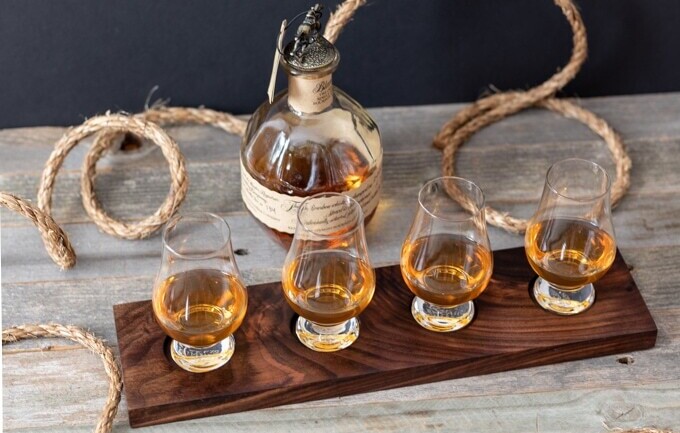Buckle up for a whiskey-tasting adventure, and it all starts by prepping your palate the right way. Kick things off with a light cocktail or a whiskey with a 40–47% ABV. This gentle wake-up call for your taste buds ensures you savor every intricate detail that follows.
The treats you choose between tastings make a big difference. Consider snacks like French bread, plain cheese, or celery—these mild foods act as a mini-reset button for your palate, allowing each new sip to shine free of lingering flavors.
The venue’s setting can make or break your tasting session. Some swear by the consistency of a non-ventilated room, while others, reminiscing about tours on the Kentucky Bourbon Trail, find an outdoor vibe adds an exciting twist. The key is picking a spot that keeps your senses sharp and consistent throughout your tasting journey.
The Essentials of Whiskey Tasting: Tools and Techniques to Optimize the Experience
A well-prepped palate deserves the right tools. That starts with picking the perfect glass. Grab a tulip-shaped, stemmed glass—it’s a game-changer. It channels those delightful aromas straight to your nose and keeps your hand warmth out of the equation, preserving every precious degree of whiskey warmth.

Take a moment to give the whiskey a good look before you dive in. Hold your glass at a 45-degree angle against a white background. The color and clarity can reveal secrets about the whiskey’s age and what kind of cask it rested in to develop its character.
Swirl the glass gently and then watch. Those streaks, known as legs, have a story to tell. Thicker, slower legs suggest a smoother ride with potentially higher alcohol content and texture—it’s like reading whiskey tea leaves!
While it might be tempting to chill your whiskey with ice, hold off on those cubes. Ice can lock down the flavors you’re trying to discover by chilling your taste buds. Keep things cozy, and you’ll taste more of what each pour has to offer.
Nosing and Tasting: Unlocking the Complex Aroma and Flavors of Whiskey
Begin your nosing by holding the glass upright, just above your nose, to catch those lighter, more volatile aromas first. It’s a gentle approach that helps your sense of smell adjust before tackling the stronger scents.
Move to deep nosing by tilting your glass towards you, nearly perpendicular to your face. This allows you to get closer and catch the heavier, more complex aromas lingering in the whiskey.
Introducing a few drops of warm water can be a revelation. This simple trick mellows the alcohol, making way for hidden flavor notes to emerge without dulling its overall intensity.
Now, go ahead and take that first sip. Let it coat your mouth and pause a second. This way, you catch the texture and initial flavors. As you continue sipping, your palate fine-tunes, picking up those subtle, layered notes that compose the whiskey’s unique profile.
Concluding the Journey: Reflecting on the Whiskey Experience
Consider the finish—the aftertaste offers a playground for flavors, and observing how long they linger paints a fuller picture of the whiskey’s character.
Keeping the tasting order in mind can heighten your experience. Start with the top-shelf selections before your senses start to tire, making sure you appreciate those finer details when you’re most alert.

Peated whiskeys deserve special attention. With their smoky, robust profiles, they can overshadow other tastings. Either savor them first or dedicate them to a separate session to enjoy their complexity without interference.
Taking notes might sound nerdy, but it’s your ticket to becoming an informed whiskey fan. Document what you see, smell, taste, and how each sip finishes. Over time, you’ll notice patterns and preferences, forming your personal whiskey map.
About Jim
Jim is the creator of Dram Discoveries, a blog dedicated to exploring and celebrating the world of whiskey. With over six years of experience, he combines a passion for whiskey’s craft and culture with a love for connecting enthusiasts through tastings, stories, and shared discoveries. For Jim, whiskey is more than a drink—it’s a journey of camaraderie, learning, and lifelong appreciation.

Whiskey is an acquired taste and the enjoyment can be improved if you have a good tasting experience. This guide to perfecting the art of tasting whiskey, is very detailed and helpful for those that would like to discover the world of whiskeys, or enhance their tasting experience.
Making sure that one has a clear pallet, before tasting a new whiskey, will give one a better taste. This is also the case when tasting wine. I will be sharing this post with all my whiskey loving friends.
Thank you so much for your thoughtful comment! I’m thrilled you found the guide helpful and detailed. You’re absolutely right—having a clear palate is key to truly appreciating the flavors of a whiskey, much like with wine. I’m delighted that you plan to share the post with your whiskey-loving friends—it means a lot! If you or your friends have any favorite tasting techniques or whiskeys you recommend, I’d love to hear about them. Cheers! 🥃